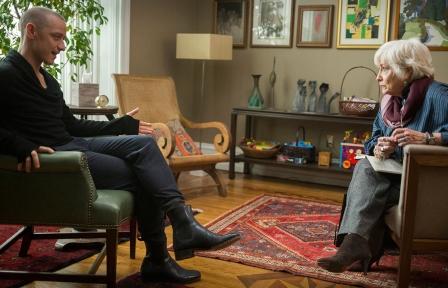Split undivided

Courtesy of Splitmovie.com.
February 23, 2017
As a horror movie enthusiast who stopped using her night light in 2010 at the tender age of 11 and suffered from E.T (1988) hallucinations, I am always up for a horror movie or a good thriller.
Director M. Night Shyamalan is known for directing “The Sixth Sense” (1999) and “The Happening” (2008) — two of my favorites. Shyamalan is known for both hits and misses. “Sense” shook audiences while he has failed to impress with “The Last Airbender” (2010) and “After Earth” (2013). I agree with this view. However, with his recent film “Split,” I believe M. Night Shyamalan successfully got a hit.
Split features a man named Kevin Crumb who suffers from a dissociative identity disorder. In the movie, this means that he has multiple personalities that are all different. Kevin’s personalities include “Dennis” who he is for the majority of the movie, along with “Patricia” and “Hedwig.” However, truly defined, DID is a severe condition in which two or more distinct identities, or personality states, are present in—and alternately take control of—an individual. The person also experiences memory loss that is too extensive to be explained by ordinary forgetfulness.
Known for his role as Professor Charles Xavier in X-Men and his role as an office worker named Wesley alongside Angelina Jolie in “Wanted” (2008), James McAvoy stretched his skills among 23 various characters all in one body during “Split.”
As Kevin, McAvoy stretches himself to play all 23 alters– all of which are extremely different. At one point, these alters can all be seen for a short period, but for the most part, only four have consistent screen time. They all have different voice styles, a different way of movement and they all have different facial expressions as well. McAvoy portrays these characters brilliantly.
I’m not exactly used to seeing movies where the character is portraying various personalities. I have seen an actor play multiple characters, however, playing multiple personalities is totally different.
I loved McAvoy in “Wanted,” but I love him even more as he portrays Kevin/Dennis/Barry/Patricia/Hedwig. Because of his role here, I have so much more appreciation for him. He is truly an amazing actor and I hope to see him be cast in more roles from now on. I grew to instantly love the chillingly creepy “Patricia” whenever she was on the screen and then I also loved nine-year old “Hedwig” who provided some comic relief after intense scenes.
Anya Taylor-Joy plays the clever lead, Casey, who uses the shocking experiences she learned from as a young girl to maneuver around each of Kevin’s alters. Compared to two stereotypical girls, who desperately look for a way to escape without thinking first, Casey concludes that it is better to wait for the right moment.
Previously, Taylor-Joy starred in the Luke Scott’s horror film, “Morgan” (2016). The opening weekend was unsuccessful, making only $504,908 at the box office. However, “Split” came in with a stunning $40.2 million in ticket sales opening weekend.
The trailer itself was chilling, exciting and to be honest, I have not seen many movies that feature a villain with multiple personalities. Because of this, I was ready to see the movie without a doubt. My friend asked me to go see a movie with him and I almost screamed my suggestion to see “Split”. I was enthusiastic before going in the movie, but it didn’t last the entire one hour and 57 minutes of the movie.
Eventually, the movie grew dull and I was ready for something insane to happen. This lack of enthusiasm was also cut short as the movie hit me with a quick plot twist that I wasn’t expecting.
People I have talked to either say the movie is a masterpiece or it is really strange. Really strange.
I do think the movie, for the most part, was excellent and it kept me on the edge of my seat for sure (I know that’s cliche to say, but I am serious).
The movie has been controversial due to those with dissociative identity disorder believing that the movie does not portray the condition properly. For example, an argument made about the movie is that mental illnesses should not be made into horror movies. Another is that the movie only supports the unfortunate stereotype that those with a mental illness are to be feared.
I understand where these beliefs come from. Research shows that those with DID are significantly more likely to hurt themselves compared to hurting others. As a result, this shows a great deal of what the movie got wrong about DID.
Mind you, “Barry” — one of Kevin’s alters with an interest in fashion — reached out numerous times to Dr. Karen Fletcher for help with the conflict going on as all of the alters competed against each other for time in the “light.” Portrayed by Betty Buckley, Dr. Fletcher’s goal was to inform others of DID. In fact, she wasn’t scared of any of Kevin’s alters. Instead, she loved all of them and thought all of them were brilliant in their own way. One argument produced from this could be that the role of the movie was to create awareness. However, a movie like this will always be “Hollywood-ized,” meaning that aspects will be to the extreme for entertainment purposes.
I do believe that the movie has portrayed mental illness incorrectly, but it is not Hollywood’s job to act in order to inform. In my opinion, Hollywood’s job is to entertain.
And we go to movies because why? To be entertained.
The movie featured fantasy elements as well, such as “The Beast”— Kevin’s 24th alter who was stronger than the others and was “on the move” as “Hedwig” told the girls to prepare themselves. Therefore, I believe that the movie was made to shock audiences and the producers truly did not mean to offend anyone suffering with DID.
Furthermore, due to the twists and the chilling acting, I rate this movie a 7/10. I cannot rate it higher than this because I left the theater feeling strange and really confused about the whole thing.
Next time, I won’t be the one picking the movie.

